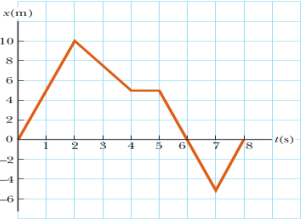1. To an order of magnitude, how many atoms are there in a cubic centimeter of a solid, if the diameter of an atom is �~ 10-10m?
2. A graph of position versus time for a certain particle moving along the x-axis is shown below. Find the average velocity in the time intervals from (a) 0 to 2.00s, (b) 0 to 4.00s, (c) 2.00 to 4.00s, (d) 4.00 to 7.00s and (e) 0 to 8.00s

3. A police car traveling at 95.0km/h is traveling west, chasing a motorist traveling at 80.0km/h. (a) What is the velocity of the motorist relative to the police car? (b) What is the velocity of the police car relative to the motorist? (c) If they are originally 250m apart, in what time interval will the police car overtake the motorist?
4. The vector position of a particle varies in time according to the expression  , where r is in meters and t is in seconds.
, where r is in meters and t is in seconds.
(a) Find an expression for the velocity of the particle as a function of time. (b) Determine the acceleration of the particle as a function of time. (c) Calculate the particle's position and velocity at t = 1s.
5. An experiment is performed on a puck on a level air hockey table, where friction is negligible. A constant horizontal force is applied to the puck, and the puck's acceleration is measured. Now the same puck is transported far into outer space, where both friction and gravity are negligible. The same constant force is applied to the puck (through a spring scale that stretches the same amount), and the puck's acceleration (relative to the distant stars) is measured. What is the puck's acceleration in outer space?
(a) It is somewhat greater than its acceleration on the Earth. (b) It is the same as its acceleration on the Earth. (c) It is less than its acceleration on the Earth.
(d) It is in�nite because neither friction nor gravity constrains it. (e) It is very large because acceleration is inversely proportional to weight and the puck's weight is very small but not zero.
6. A 3.00kg object undergoes an acceleration given by  Find (a) the resultant force acting on the object and (b) the magnitude of the resultant force.
Find (a) the resultant force acting on the object and (b) the magnitude of the resultant force.
7. A magician pulls a tablecloth from under a 200g mug located 30.0cm from the edge of the cloth. The cloth exerts a friction force of 0.100N on the mug, and the cloth is pulled with a constant acceleration of 3:00m=s2. How far does the mug move relative to the horizontal tabletop before the cloth is completely out from under it? Note that the cloth must move more than 30cm relative to the table-top during the process.
8. The average speed of a nitrogen molecule in air is about 6:70 � 102m=s, and its mass is 4:68�10 26kg. (a) If it takes 3:00�10 13s for a nitrogen molecule to hit a wall and rebound with the same speed but moving in the opposite direction, what is the average acceleration of the molecule during this time interval? (b) What average force does the molecule exert on the wall?
9. A toy rocket engine is securely fastened to a large puck that can glide with negligible friction over a horizontal surface, taken as the xy plane.
The 4kg puck has a velocity of �3^ i m=s at one instant. Eight seconds later, its velocity is  . Assuming the rocket engine exerts a constant horizontal force, �nd (a) the components of the force and (b) its magnitude.
. Assuming the rocket engine exerts a constant horizontal force, �nd (a) the components of the force and (b) its magnitude.
10. A 10.0g object moving to the right at 20.0cm/s makes an elastic head-on collision with a 15.0g object moving in the opposite direction at 30.0cm/s. Find the velocity of each object after the collision. Hint: momentum and kinetic energy are conserved in elastic collisions.